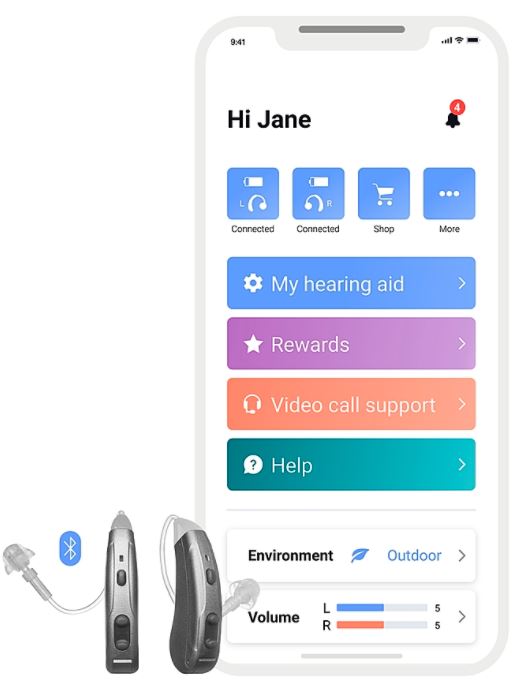By Stephen O. Frazier
That’s a question more and more people are asking as they move from denial into that place where they accept that they have a hearing loss and need to do something about it.
The simple answer could be that they cost so much because of a lack of research before buying.
More than one business has used the slogan, “An educated consumer is our best customer.” With the advent of the Internet a world of knowledge and information is at our fingertips including all you could possibly want to know about hearing loss and its treatment. The latter includes a world of information on the many types of hearing aids, their cost, and where to buy them.
Hearing Aids Already Available in a Range of Prices
Online a person can pay anywhere from as little as $2,750 to $4,500 for the same exact pair of Signia Pure Charge&Go 7X behind the ear hearing aids that they would pay as much as $6,000 for in a local hearing care office. That low price is available online from Hear.com, a company owned by the maker of Signia hearing aids (WS Audiology) with other online sellers at a variety of prices ranging up to $4,500 for the same hearing aids.
The example cited here is a pair of upper tier hearing aids whose features are pretty much duplicated by the BiCore model in WS’s lower priced Rexton line. The Rextons sell for just $1,799.99 at Costco and the price for accessories such as a remote mic are also lower than you might pay elsewhere. You can take another $400 of the cost of a pair of hearing aids at Costco if you buy their private label Kirkland 10 hearing aids made by Sonova – a major and highly respected hearing aid manufacturer (parent company to Phonak).

If the $1,399.99 Kirkland price is still beyond your budget, a pair of FDA approved Bose SoundControl hearing aids will set you back just $849.00. Bose is new to the hearing aid market but well known for top quality sound equipment of various types. Their new hearing aids will no doubt meet the expected standards currently being finalized by the FDA for over-the-counter (OTC) hearing aids as they have already received FDA approval by meeting prescription hearing aids standards. They are reportedly appropriate for people with a mild to moderate hearing loss and, paired with the Bose Hear app, users can adjust their hearing aid settings without the help of a hearing care professional. The Bose devices offer Bluetooth but lack some of the other bells and whistles of more expensive prescription hearing aids such as audio streaming and rechargeability but would apparently fall into the upper price range expected for OTC devices if Bose were to move them to that market.
Dr. Justin Golub, an ear specialist at Columbia University Medical Center in New York was quoted in Forbes Magazine as expecting OTC hearing aids to cost $200 to $800 for a pair and felt other big electronics names like Samsung and Apple might jump on board the OTC ship. Hearing Tracker even reports that of Proctor and Gamble’s getting into the hearing aid business, marketing what appear to be devices in the same price range as Bose under the Braun brand name.
OTC Hearing Aids on Horizon
OTC hearing aids are not here yet, but there are already medical grade hearing aids on the market that fall into that expected price range. One of them is the Lexie Lumen model hearing aids, which can be found for sale on the Walgreen’s website.
At $799, these are not state-of-the-art hearing aids. They don’t offer receiver in the canal technology – the receiver is in the hearing aid and transmits sound to the ear via a small tube as other BTE hearing aids did quite successfully ten years ago – but they do offer other features that could be considered premium that the Bose product does not have.

They do offer telecoil functionality, a technology that receives and sends sound from a silent electromagnetic signal from an induction hearing loop to the ear. Thus, they are compatible with the assistive listening systems now required in all new or upgraded places of assembly that feature an electronic public address system. This is a feature not even found in some of the most expensive hearing aids on the market and one that “educated consumers” such as members of the Hearing Loss Association of America (HLAA) demand in their hearing aids.
The Lexie devices are not rechargeable, requiring that the batteries be regularly replaced like most older prescription hearing aids and many new ones, but they do feature smart phone connectivity via Bluetooth and an app that will let the user change the volume and other settings to serve his or her personal preferences.
That Bluetooth connectivity also can be used to operate an available optional remote microphone. The user of that mic can be across the table from the hearing aid wearer or across the room – another feature the Bose devices don’t offer. The frosting on the cake for Lexie is not the $799 price, it’s the option of $49 monthly payments to cover that cost as an alternative to one single payment.
Unlike Lexie and their single model, online seller Otofonix offers a half dozen different models with retail prices ranging from $980 to $3,200 a pair but currently being offered at $790 to $1,590. Depending on the model, the company offers devices with telecoils, rechargeability, smart phone compatibility and four to six different programs to meet various listening conditions. From the lowest priced model and its four preset and unchangeable programs, options vary by model and can even include an initial hearing test built into the smart phone app to get you started with the devices.
Testing
Many companies offer an online hearing test that can help determine your hearing levels. Also, for some online sellers, you will be referred to a local hearing care provider for a test and, if called for, the dispensing of a pair of hearing aids you previously selected online.
If, like the Lively online program, they don’t currently use a local provider, many reputable online sellers will have an audiologist or hearing instrument specialist review your audiogram and adjust the hearing aids accordingly before they are shipped to you.
With Bose and some of the others you’re provided written instructions and make the necessary adjustments using a smartphone and the app for the device. Instead of default settings being determined and made by a computer, you make real life settings yourself based on what you are hearing and how it sounds. In many cases that’s what ends up being done anyway.
The True Cost of Hearing Aids
Lastly in this discussion of hearing aid cost, what is “so much”? What is the ability to actually hear what others are saying worth?
What is it worth to be able to find or keep a job or to hear the sermon in a place of worship, to be a participant in society rather than an observer?
Many like to use the argument that hearing aids are just too expensive – that they would get them if the price was lower. A recent study found that in England, where hearing aids are free, the percentage of people who could benefit from them and have them was not appreciably higher than it is here in the US – in some age groups it was actually lower – so their cost seems to be an excuse rather than a reason for not buying hearing aids.
So… if you or someone close to you suspects a hearing loss – for the computer literate, go online and do some research. You’ll find hearing aids for the vast majority of people with a hearing loss don’t need to cost several thousand dollars to meet their needs. You could possibly save thousands, and the recipient of the new hearing aids is bound to hear better. The results may not always match those for hearing aids fitted by a highly trained hearing instrument specialist or audiologist but they’ll still be worth every penny you paid.
For those who are computer challenged, enlist the help of a relative or friend who knows how to traverse the digital universe of the Internet to help you, and get some hearing aids so you can rejoin society and live life at least somewhat more happily for ever after.
About the Author
Stephen Frazier is a freelance writer and the former New Mexico HLAA Chapter Coordinator. He was trained by HLAA as a hearing loss support specialist, maintains the Loop New Mexico initiative, co-chairs the Committee for Communication Access in New Mexico, and was one of the founding members of the national HLAA Get in the Hearing Loop Task Force. His articles have run in many publications including the audio/visual magazine Sound & Communications, Advance for Audiologists, the Christian Science Monitor, Church Executive, Hearing Review, Hearing Health and many others. Those articles can be read at www.sofnabq.com








Hi Stephen
Thanks for a great article. Do you know who is the maker behind Lexie Lumen? By any chance might it be phonak? Is the microphone mentioned a les expensive “Roger” device that might work with my Phonak aids?
Les Greenberg. N-CHATT
HLAA , Chapter Lead
Prince Georges County, MD
Hey Les,
The Lexie Lumen hearing aids are not made by Phonak, they are made by Intricon. If I understand correctly, the Roger mics are proprietary and would only work with Phonak products that have the correct receiver for them.